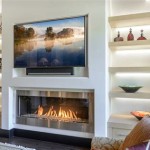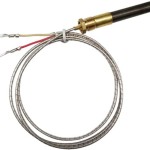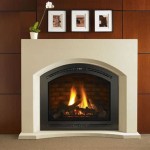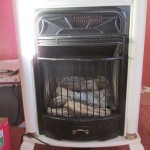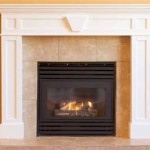White Gel Fireplaces: Aesthetics, Functionality, and Considerations
White gel fireplaces offer a contemporary and often minimalist approach to home heating and ambiance. These fireplaces utilize a clean-burning gel fuel, typically composed of isopropyl alcohol or ethanol, that produces a real flame without the need for chimneys, vents, or gas lines. The "white" aspect refers primarily to the fireplace's exterior housing, often constructed from materials like painted metal, ceramic, or composite stone, designed to complement modern interior design schemes.
The popularity of white gel fireplaces stems from their ease of installation, portability, and aesthetic versatility. They can be incorporated into a variety of spaces, from apartments and condominiums to homes and offices, providing a focal point of warmth and visual appeal. However, it's crucial to understand the features, benefits, and safety considerations associated with white gel fireplaces before making a purchase.
Understanding Gel Fuel and Combustion
The core technology behind a gel fireplace is the gel fuel itself. This fuel is typically sold in canisters or bottles and is designed to burn cleanly, producing minimal soot or smoke. The primary components of gel fuel are alcohols, which, when combusted, primarily release carbon dioxide and water vapor. This makes gel fireplaces an appealing option for individuals seeking a relatively clean-burning alternative to traditional wood-burning fireplaces. However, it's imperative to adhere strictly to the manufacturer's instructions regarding fuel usage and fireplace operation.
The heat output of a gel fireplace is generally lower than that of a wood-burning or gas fireplace. The amount of heat generated depends on the size of the flame and the type of gel fuel used. Therefore, gel fireplaces are often used more for aesthetic appeal and supplemental heating rather than as a primary source of warmth for a large room. The flame duration is also dependent on the fuel canister size, typically ranging from one to three hours per canister.
The combustion process of gel fuel requires oxygen. Adequate ventilation is crucial to ensure the fire burns efficiently and to prevent the buildup of carbon monoxide, even though the emission levels are low. While gel fireplaces are considered ventless, it's still essential to operate them in well-ventilated areas.
Benefits of Choosing a White Gel Fireplace
White gel fireplaces offer several advantages, particularly for those seeking a readily accessible and visually striking heating solution. Their ventless design eliminates the need for costly and complex chimney installations, making them suitable for apartments and homes without existing fireplace infrastructure. This significantly reduces the upfront investment compared to conventional fireplaces.
Their portability is another key benefit. Many white gel fireplaces are lightweight and can be easily moved from room to room or even taken outdoors for use on patios or decks. This flexibility allows users to enjoy the ambiance of a fire in various settings. The aesthetic appeal of a white fireplace is also a major draw, as white seamlessly integrates into a variety of interior design styles, creating a clean and modern look. This neutral color provides a blank canvas, allowing the fireplace to complement existing décor and furnishings.
Moreover, white gel fireplaces are relatively easy to operate and maintain. Lighting the fire typically involves using a long lighter or match to ignite the gel fuel, and extinguishing the flame can be done by simply covering the canister with a snuffer or lid. Maintenance primarily involves cleaning the exterior housing and occasionally replacing the fuel canisters.
Safety Considerations and Operational Best Practices
Despite their ease of use, white gel fireplaces require careful attention to safety. Because they produce a real flame, it is essential to follow all manufacturer's instructions and adhere to basic fire safety precautions. Never leave a burning gel fireplace unattended. Constant supervision is paramount, especially when children or pets are present. Keep flammable materials, such as curtains, furniture, and paper, away from the fireplace.
Only use gel fuel specifically designed for gel fireplaces. Using alternative fuels can be dangerous and may result in an uncontrolled fire or the release of harmful fumes. Always store gel fuel in a cool, dry place away from heat and open flames. When refilling the fireplace, ensure the flame is completely extinguished and the canister has cooled down before adding more fuel. Refilling a hot canister can cause a flash fire.
It is critical to ensure adequate ventilation in the room where the gel fireplace is being used. While gel fireplaces produce a relatively low level of carbon monoxide, proper ventilation will help prevent any buildup of the gas. Smoke detectors and carbon monoxide detectors should be installed and regularly checked to ensure they are functioning correctly. In the event of a fire, have a fire extinguisher readily available and know how to use it.
Furthermore, consider the surface on which the fireplace is placed. Ensure the surface is stable, level, and non-flammable. Some white gel fireplaces may come with heat-resistant mats or bases to protect the underlying surface. Regular cleaning of the fireplace is also vital to prevent the accumulation of dust and debris, which could pose a fire hazard.
When choosing a white gel fireplace, examine the construction and materials used. Ensure the fireplace is made from durable, heat-resistant materials and that it is designed to contain the flame safely. Consider models with safety features, such as tip-over protection, which can automatically extinguish the flame if the fireplace is accidentally knocked over.
The size and shape of the fireplace should also be considered. A larger fireplace may produce more heat but will also require a larger fuel canister and more space. Choose a size that is appropriate for the room and the intended use. Different shapes, such as rectangular, square, or cylindrical, can complement different design aesthetics.
Regularly inspect the gel fuel canisters for any signs of damage, such as leaks or dents. Damaged canisters should be discarded properly and not used in the fireplace. Follow all local regulations and guidelines regarding the use and storage of gel fuel. Be aware of any potential restrictions on the use of open flames in apartments or condominiums.
Finally, it is important to remember that a white gel fireplace is not a substitute for a traditional heating system. It is primarily intended for supplemental heating and aesthetic purposes. Do not rely on a gel fireplace as a primary source of warmth, especially in cold climates.

Silverton G8600 W White Gel Fireplace Just Fireplaces

Real Flame Ashley Indoor Gel Fireplace White Com

Best Buy Real Flame Cau Gel Fireplace Indoor Usage Heating Capacity 2 64 Kw White 5910

Cau 5910 W White Gel Fuel Fireplace Just Fireplaces

Grisun 26 8 Large Gas Fireplace Logs Ceramic White Birch Wood For Indoor Inserts Outdoor Firebowl Fire Pits Vented Propane Gel Ethanol Electric Realistic Decoration 6 Pcs Com

Best Buy Real Flame Porter Indoor Ventless Gel Fireplace White 7730

Silverton G8600 W White Gel Fireplace Just Fireplaces

Discontinued Real Flame Gabrielle Ventless Gel Fireplace Antique White L6700 Aw

Indoor Fireplaces Bed Bath Beyond White Electric Fireplace

White Stone Gel Outdoor Tabletop Fireplace
Related Posts

